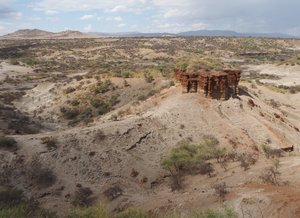Advertisement
Published: October 5th 2023

 Olduvai Gorge
Olduvai Gorge
Name from Maasai word oldupai which means "the place of the wild sisal" We entered the Ngorongoro Conservancy, where live many
Maasai. They were moved here from the Serengeti when it became a National Park mid-last-century. In five years, they will be moved again, because their population has increased a lot, and because Ngorongoro soon will become a National Park. Unlike other people, Maasi are allowed to live in the Conservancy, because they don’t kill what they cannot keep in herds; in other words, they don’t kill wild animals. We saw their large herds of goats, and a few cattle, with herd boys driving the animals or standing by watching. Their walled villages dot the countryside.
One of the oldest locations of human and pre-human bones is inside the Conservancy. The internationally famous
Olduvai Gorge is marked by an excellent small museum. Before entering the museum building, we sat in an outdoor auditorium overlooking the astonishing ancient river course at the bottom of a steep gorge. The resemblance to the
Badlands area of Alberta was striking, except it was steeper and larger and more colourful. Pointing to several excavation sites in the deep reddish gorge, a museum guide related the geological history and the discovery of pre-human and human remains. Although I listened with

 Goats feeding on bushes
Goats feeding on bushes
Minimal food during the dry season interest, I couldn’t keep the details in my mind. Going through the museum helped, as the information was well written on display panels adjacent to artifacts. The most singular and precious bones were replicas; the originals were in more established museums.
Louis and Mary Leakey and their colleagues worked a life-time in this and other related African sites. Archeologists still work in this gorge to learn more about the earliest human ancestors.
Back on the road, we followed the gorge for some time, and then began the long, steep rise to the edge of the Ngorongoro Crater. Although new, the engine in the other of our vehicles overheated. Stopped some way back, we could see nothing at first. Then, Lucas came back and wordlessly collected an armful of bottles of water from the stash in our vehicle. In a few minutes, the two drivers and Lucas leapt back – out of the way of steam rising from the radiator. A park ranger also stopped and provided three big bottles of water. Some passing tourist vehicles stopped to check that things were ok, but some others just drove on by. I took the opportunity to photograph the dry landscape covered in acacia trees,

 Lake Magadi
Lake Magadi
Moon shining through the cloudmany leafless in this late season. Goats stretched themselves up on their hind legs to reach the dusty leaves left by others. Farmers’ donkeys passively nibbled old grass.
Underway again, we finished the climb and drove along the edge of the Crater, but we couldn’t see inside. Although called a crater, Ngorongoro is actually a caldera, that is, a collapsed volcano. The ash and dirt from the collapse was blown west and made the Serengeti plain.
The
Serena Ngorongoro hotel was built to provide every room a view over the crater. Unfortunately, in the evening, when we arrived, it was socked in by cloud, according to the porter who wheeled my luggage to my room with its balcony. Later I heard that it actually was dust, not cloud. In any case, seeing inside the crater was initially impossible. As night settled in, the dust/cloud receded. Beautifully, the full moon was reflected in the blue lake at the bottom.
Before dinner, a Maasai group performed traditional dances in the restaurant lobby. On the way in, I bought a Maasai Shuka blanket (US$15), because I love the bright red colour of the cloth, although now bright pink is also popular. The
young dancers paraded in slowly, accompanying themselves with ear-piercing singing. A long horn I could barely see kept a strong resonant beat. The men did the jumping characteristic of Maasai dance. They jumped three times silently on their toes, then landed very hard on the soles of their flat sandals, making a loud cracking sound. Obviously, it was a competitive show of prowess – even in this demonstration. The women had both wide necklaces and shiny long necklaces. Shrugging their shoulders and tipping their necks made the two necklaces wave in a rhythm, while the dancers held their blankets tight around their bodies. At the climax, each man showed his best jumping and each woman made her necklaces continuously shimmer.
Dinner: broth with finely chopped chicken and vegetables, cold beets as salad, curried mutton with chapati and rice.
Our elevation at the crater floor: 1800 metres
View map to date. [youtube=
]
Advertisement
Tot: 0.082s; Tpl: 0.015s; cc: 12; qc: 26; dbt: 0.0314s; 1; m:domysql w:travelblog (10.17.0.13); sld: 1;
; mem: 1.2mb




























Isabel Gibson
non-member comment
The scale of it is hard to get, isn't it -- both spatially and temporally? Imagine the volcano whose ejecta "filled in" (covered over?) the adjacent area to make the plain. And I wonder when the wind erosion will get around to finishing off those remnant red pillars sticking up in the middle. As for the dancers, I wonder how long it takes the women to get proficient at shimmering their necklaces without seeming to move any other part of their bodies. In a way it looks simple but I bet it ain't simple.